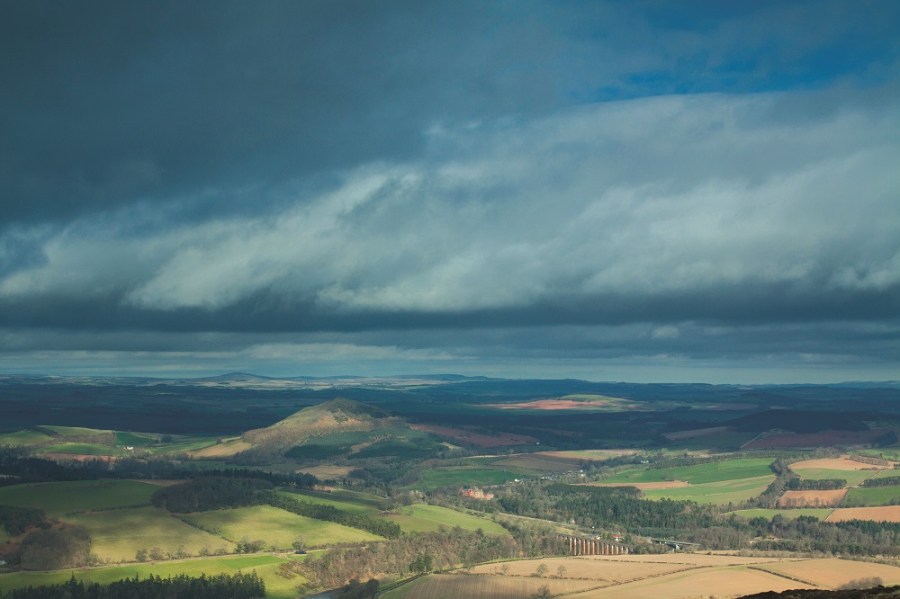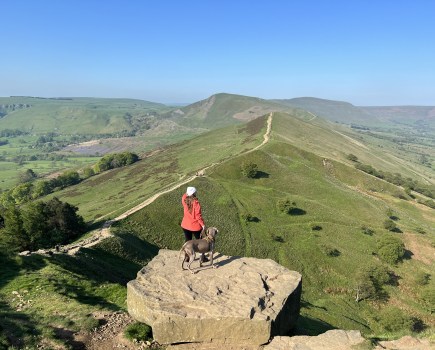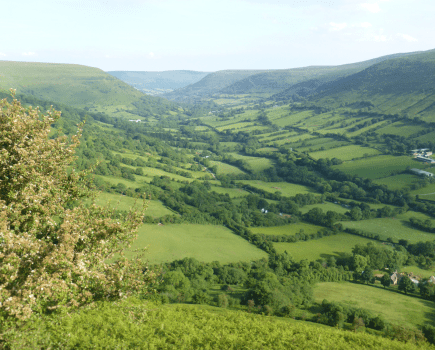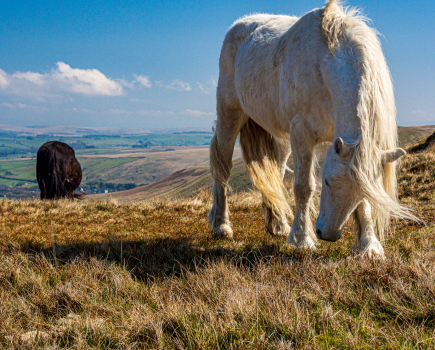Keith Fergus crosses a land of wizards and warriors
The Romans named them Trimontium, literally translating as ‘the Three Mountains’, and their distinctive profile dominates the village of Melrose in the Scottish Borders, which sits comfortably at their base. Yet the Eildon Hills were utilised by locals as a place of refuge long before the Romans set up camp and the Old English translation simply means ‘Old Hill Fort’. Local folklore suggests that the wizard Michael Scot split the one hill into three, using his mysterious powers, and therefore providing the Eildon Hill’s with their most distinguishing feature.
Today these steep sided hills grant a superb half-day hill walk where the legs and lungs receive a good workout and a series of far-reaching views stretch out across a magnificent and historic landscape.
I walked through Melrose’s quiet streets, not long after dawn, passing the distinctive ruins of Melrose Abbey. It was established in 1136 by David I and was the first Cistercian monastery to be built in Scotland.
The fertile lands surrounding the River Tweed attracted the Cistercian monks of Rievaulx in Yorkshire to settle here, and this continued for the next 450 years with the last resident monk dying around 1590. Melrose Abbey is also thought to be where Robert the Bruce’s heart is buried.
I continued towards the village of Newstead, reputedly the oldest inhabited village in Scotland, but the gentle stroll soon came to a halt as 200-metres of thigh-bursting slopes took me quickly onto the flat-topped North Hill where I was welcomed with a cool breeze. Around the time of the Bronze Age up to 2,000 people lived on the Eildon Hills, many of them on North Hill and my vista today took in Mid Hill, Melrose, the River Tweed and much of the Scottish Borders.
A simple descent picked up a short section of the St Cuthbert’s Way where I spotted a hen harrier hovering above the heathery hillside, eyes fixed on a particular spot, presumably its next meal. An easy rise led onto Wester Hill where I gazed along the long ridgeline of the Cheviot Hills.
I gave a quick nod and hello to a fellow walker before taking the final steep ascent of the day, one that gained Mid Hill, the highest point of the route and another fabulous vantage point – the Berwickshire Coast was a faint outline in the distance as were the mighty Lake District mountains.
With vistas like this it was easy to see why the Romans occupied these hills around the 3rd century AD, sending their long distance messages across the predominantly flat countryside.
A short descent led back to the St Cuthbert’s Way and a final walk back into welcoming confines of Melrose.
Route description
Start/Finish: Market Square, Melrose
- From Market Square follow Abbey Street to Melrose Abbey. Turn R follow Priorswalk through park onto pavement. As it swings R turn L onto path and continue for 0.5 miles to Dean Road at Newstead.
- Turn L then R onto Borders Abbey Way, climb gradually through woodland to waymarked junction. Go R, pass under railway bridge then underpass beneath A6091. Upon reaching A6091 turn L, take left-hand of 2 gates, climb track to minor road.
- Turn R descend road for few metres, turn L onto path. Climb SW onto Eildon North Hill.
- From top, take right-hand path, descend SW then S around lower slopes of Mid Hill to col in-between Mid and Wester Hill. Cross track (beside Melrose Paths post) and climb onto Wester Hill.
- Retrace steps to Melrose Paths marker. Turn L, head W then ascend NE onto Mid Hill. Beyond trig descend path to col in-between North and Mid Hill. Follow St Cuthbert’s Way N then NW back to Melrose at Dingleton Road. Turn R, return to Market Square.
Keith Fergus crosses a land of wizards and warriors
The Romans named them Trimontium, literally translating as ‘the Three Mountains’, and their distinctive profile dominates the village of Melrose in the Scottish Borders, which sits comfortably at their base. Yet the Eildon Hills were utilised by locals as a place of refuge long before the Romans set up camp and the Old English translation simply means ‘Old Hill Fort’. Local folklore suggests that the wizard Michael Scot split the one hill into three, using his mysterious powers, and therefore providing the Eildon Hill’s with their most distinguishing feature.
Today these steep sided hills grant a superb half-day hill walk where the legs and lungs receive a good workout and a series of far-reaching views stretch out across a magnificent and historic landscape.
I walked through Melrose’s quiet streets, not long after dawn, passing the distinctive ruins of Melrose Abbey. It was established in 1136 by David I and was the first Cistercian monastery to be built in Scotland.
The fertile lands surrounding the River Tweed attracted the Cistercian monks of Rievaulx in Yorkshire to settle here, and this continued for the next 450 years with the last resident monk dying around 1590. Melrose Abbey is also thought to be where Robert the Bruce’s heart is buried.
I continued towards the village of Newstead, reputedly the oldest inhabited village in Scotland, but the gentle stroll soon came to a halt as 200-metres of thigh-bursting slopes took me quickly onto the flat-topped North Hill where I was welcomed with a cool breeze. Around the time of the Bronze Age up to 2,000 people lived on the Eildon Hills, many of them on North Hill and my vista today took in Mid Hill, Melrose, the River Tweed and much of the Scottish Borders.
A simple descent picked up a short section of the St Cuthbert’s Way where I spotted a hen harrier hovering above the heathery hillside, eyes fixed on a particular spot, presumably its next meal. An easy rise led onto Wester Hill where I gazed along the long ridgeline of the Cheviot Hills.
I gave a quick nod and hello to a fellow walker before taking the final steep ascent of the day, one that gained Mid Hill, the highest point of the route and another fabulous vantage point – the Berwickshire Coast was a faint outline in the distance as were the mighty Lake District mountains.
With vistas like this it was easy to see why the Romans occupied these hills around the 3rd century AD, sending their long distance messages across the predominantly flat countryside.
A short descent led back to the St Cuthbert’s Way and a final walk back into welcoming confines of Melrose.
Route description
Start/Finish: Market Square, Melrose
- From Market Square follow Abbey Street to Melrose Abbey. Turn R follow Priorswalk through park onto pavement. As it swings R turn L onto path and continue for 0.5 miles to Dean Road at Newstead.
- Turn L then R onto Borders Abbey Way, climb gradually through woodland to waymarked junction. Go R, pass under railway bridge then underpass beneath A6091. Upon reaching A6091 turn L, take left-hand of 2 gates, climb track to minor road.
- Turn R descend road for few metres, turn L onto path. Climb SW onto Eildon North Hill.
- From top, take right-hand path, descend SW then S around lower slopes of Mid Hill to col in-between Mid and Wester Hill. Cross track (beside Melrose Paths post) and climb onto Wester Hill.
- Retrace steps to Melrose Paths marker. Turn L, head W then ascend NE onto Mid Hill. Beyond trig descend path to col in-between North and Mid Hill. Follow St Cuthbert’s Way N then NW back to Melrose at Dingleton Road. Turn R, return to Market Square.








